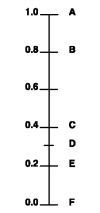Resource allocation, social values and the QALY: a review of the debate and empirical evidence
- PMID: 12199660
- PMCID: PMC5060157
- DOI: 10.1046/j.1369-6513.2002.00182.x
Resource allocation, social values and the QALY: a review of the debate and empirical evidence
Abstract
Most health economists agree that public preferences should play a major role in setting criteria for distributing scarce resources. The quality-adjusted life year (QALY) is used as a preference-based measure for the outcome of health-care activities in health economic evaluative studies. Traditionally, health economists proposed maximizing the additional health gain in terms of QALYs so as to maximize social welfare. Evidence has grown however, that neither potential health gain as a single relevant determinant of value, nor the rule of maximizing this health gain are sufficient. Concerns about fairness and equity are also important to the public in distributional decisions. This paper reviews the debate on the role and limitations of the QALY in health-care priority setting and the empirical evidence surrounding it. A framework is used to systematically explore the available data on factors considered to be important to the public in health-care resource allocation, and to investigate how these fit with the implicit value judgements inherent in the original QALY formulation. Potential sources of social value are classified into (1) factors that relate to the characteristics of patients and (2) factors related to the characteristics of the intervention's effect on patients' health. As well as these main categories, the article considers preferences for distributional rules. Recent approaches that aim to capture public preferences more comprehensively and to better reflect the value attributed to different health-care programmes in economic evaluation methods are outlined briefly.
Figures
Similar articles
-
[Cost-utility analysis as a mechanism for allocation of health care resources: a review of the debate].Cad Saude Publica. 2009 Feb;25(2):239-50. doi: 10.1590/s0102-311x2009000200002. Cad Saude Publica. 2009. PMID: 19219231 Review. Portuguese.
-
Inquiry into the relationship between equity weights and the value of the QALY.Value Health. 2012 Dec;15(8):1119-26. doi: 10.1016/j.jval.2012.07.002. Epub 2012 Sep 25. Value Health. 2012. PMID: 23244815
-
Societal preferences for distributive justice in the allocation of health care resources: a latent class discrete choice experiment.Med Decis Making. 2015 Jan;35(1):94-105. doi: 10.1177/0272989X14547915. Epub 2014 Aug 21. Med Decis Making. 2015. PMID: 25145575
-
Preferences, needs and QALYs.J Med Ethics. 1996 Oct;22(5):267-72. doi: 10.1136/jme.22.5.267. J Med Ethics. 1996. PMID: 8910777 Free PMC article. Review.
-
QALY-maximisation and public preferences: results from a general population survey.Health Econ. 2002 Dec;11(8):679-93. doi: 10.1002/hec.695. Health Econ. 2002. PMID: 12457369
Cited by
-
Valuing QALYs in Relation to Equity Considerations Using a Discrete Choice Experiment.Pharmacoeconomics. 2015 Dec;33(12):1289-300. doi: 10.1007/s40273-015-0311-x. Pharmacoeconomics. 2015. PMID: 26232199 Free PMC article.
-
Empowering local research ethics review of antibacterial mass administration research.Infect Dis Poverty. 2022 Sep 28;11(1):103. doi: 10.1186/s40249-022-01031-6. Infect Dis Poverty. 2022. PMID: 36171611 Free PMC article. Review.
-
Cost-Effectiveness Analysis of Temocillin Treatment in Patients with Febrile UTI Accounting for the Emergence of Antibiotic Resistance.Appl Health Econ Health Policy. 2022 Nov;20(6):835-843. doi: 10.1007/s40258-022-00748-7. Epub 2022 Aug 22. Appl Health Econ Health Policy. 2022. PMID: 35989360 Free PMC article.
-
What defines the "value" of robotic surgery for patients with gastrointestinal cancers? Perspectives from a U.S. Cancer Center.Ann Gastroenterol Surg. 2024 Mar 21;8(4):566-579. doi: 10.1002/ags3.12792. eCollection 2024 Jul. Ann Gastroenterol Surg. 2024. PMID: 38957558 Free PMC article. Review.
-
Balancing equity and efficiency in the Dutch basic benefits package using the principle of proportional shortfall.Eur J Health Econ. 2013 Feb;14(1):107-15. doi: 10.1007/s10198-011-0346-7. Epub 2011 Aug 26. Eur J Health Econ. 2013. PMID: 21870179 Free PMC article.
References
-
- Gold MR, Siegel JE, Russell LB, Weinstein MC. Cost‐Effectiveness in Health and Medicine. Oxford: Oxford University Press, 1996.
-
- Nord E. Cost‐Value Analysis in Health Care MakingSense Out of QALYs. Cambridge: Cambridge University Press, 1999.
-
- Nord E, Pinto‐Prades J‐L, Richardson J, Menzel P, Ubel P. Incorporating societal concerns for fairness in numerical valuations of health programmes. Health Economics , 1999; 8: 25–39. - PubMed
-
- Ubel PA, Nord E, Gold M et al. Improving value measurement in cost‐effectiveness analysis. Medical Care , 2000; 38: 892–901. - PubMed
-
- Menzel P, Gold MR, Nord E et al. Toward a broader view of values in cost‐effectiveness analysisof health. Hastings Center Reports , 1999; 29: 7–15. - PubMed
Publication types
MeSH terms
LinkOut - more resources
Full Text Sources
Research Materials


